How do you feel about your Japanese pronunciation? Depending on your native language, a lot of it is very easy. You can produce accurate sounds, similar to those of a native Japanese speaker.
Spend an hour going through this page. You'll be able to apply these concepts literally every time you use or study Japanese.
But, there are a few sounds that most people aren't doing right. R's and F's, for example. Beyond that, there are pronunciation challenges such as long vowels, double consonants, the nasal が, and pitch accent. Not to mention it all gets ten times more difficult once you start applying these concepts to sentences, not just words.
Can Japanese people understand you even if you don't do all of those things? Probably. But to us, learning proper pronunciation is part of the fun. And, don't you want to speak the best Japanese you possibly can? It's not as hard as you think to make progress with your pronunciation. Instead of ignoring it, spend an hour going through this page. You'll be able to apply these concepts literally every time you use or study Japanese.
We're going to start with foundational work first, then build from there. As you read, try it all out: the mouth shapes, the sounds, the tongue positions—I think you'll be surprised at how much you're able to improve in such a short time.
- Japanese Sounds and Writing
- Japanese Sounds and Your Mouth
- Consonants
- Important Differences
- Pronouncing Vocabulary
- Pitch and Speaking Japanese
- Pronouncing Phrases and Sentences
Prerequisite: This guide is going to use hiragana and some katakana, so we highly recommend you learn it beforehand by reading our guides. Don't worry! They can be learned in a day or two, just come back when you're ready. The final section will include Japanese sentences that fall around the intermediate level.
Japanese Sounds and Writing

First, we need to start with the sounds that are available to us. For that, we look at written Japanese, which is made up of three parts.
- Hiragana
- Katakana
- Kanji
Hiragana and katakana are phonetic syllabaries, which is a fancy way of saying two things:
- The symbols represent sounds
- Each symbol represents a syllable
While hiragana and katakana look different, they both represent the same sounds, they just have different uses. Kanji are the characters borrowed from China, but luckily, you don't have to worry about kanji or katakana right now. Let's focus on hiragana and how understanding it can help you with Japanese pronunciation.
Each hiragana symbol represents a syllable sound. This is different from English in a few different ways. First, just because you know how to pronounce a word in English doesn't mean you know how to spell it. English is notoriously difficult to learn for many reasons, but a big one is that spelling and pronouncing words can be a big headache. We have words like colonel, recipe, through, and threw. It's a fascinating mess.
Japanese, on the other hand, has mostly kept up with how words are pronounced and written. This means that what you see is (almost always) what you get, and if you can say it, you can spell it, and vice versa1.
Syllables and Spelling
Understanding that Japanese is made up of phonetic syllables is incredibly helpful when it comes to understanding how to pronounce them.
Each hiragana symbol represents a syllable.
There are vowels: あいうえお
And consonants plus vowels: かきくけこ (and the rest)
Instead of splitting up their individual sounds, Japanese keeps these sounds in larger chunks. For example, if you wanted to express the sound か in English it would be spelled "ka" with the consonant k and the vowel a. For ち it would be two consonants to make the sound ch (c+h) and the vowel i. Instead of separating everything into its smallest part or combinations to represent unique sounds (like ch) with letters, Japanese uses syllables to make the same sound using fewer symbols.
I could get a lot deeper into syllables and how they differ in Japanese, but this is enough to understand pronouncing Japanese for now. If you'd like to learn more, you can always head over to our article on haiku, and read the section on mora (the Japanese equivalent to syllables).
Understanding that Japanese is made up of phonetic syllables (syllables that directly correlate to a sound) is incredibly helpful when it comes to understanding how to pronounce them.
Japanese Sounds and Your Mouth

Every sound in a language, Japanese included, can be explained by the place where the sound originates and the movements of your mouth, nose, and throat. We're going to learn some terms that you can use to help understand these sounds in Japanese.
In some languages, these placements and the variations between them can get complicated, but Japanese doesn't have many sounds compared to languages like English or Mandarin or Russian, so you're already at an advantage!
Japanese Vowels
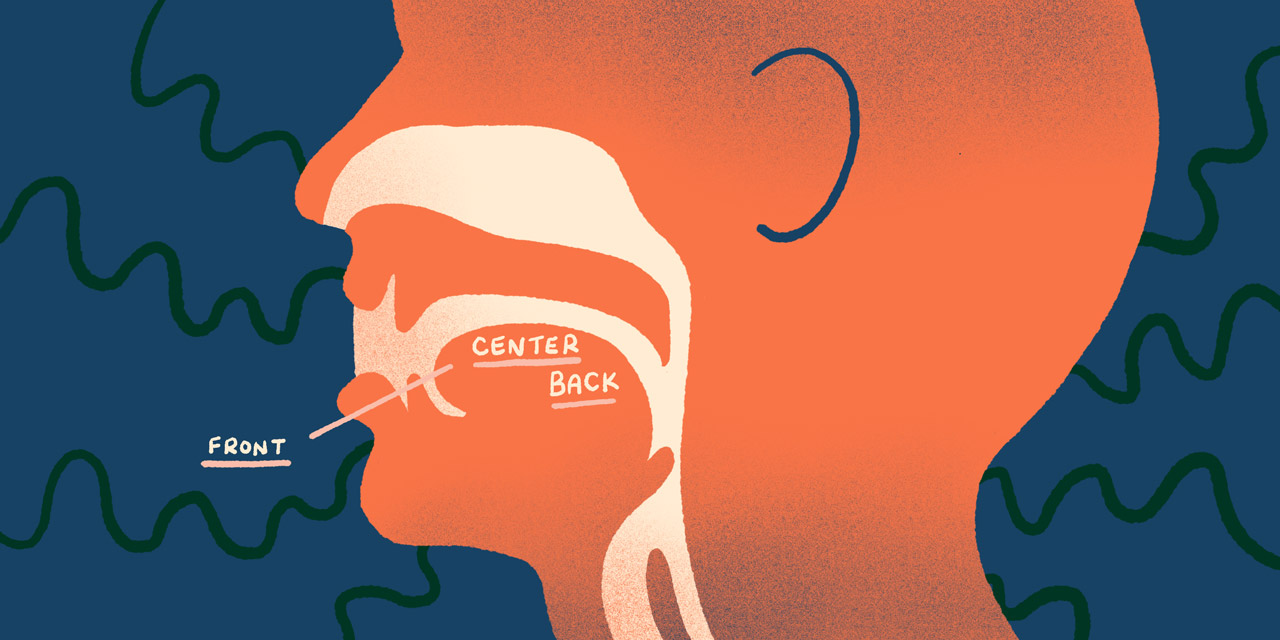
Let's begin with the least complicated sounds in Japanese: vowels. Vowels are made when the air coming out of your lungs is not blocked by anything. That air travels from your lungs, vibrates through your vocal cords, and out of your mouth without anything else getting in the way.
The only thing that distinguishes vowel sounds from each other is the placement of your tongue as the air comes out of your mouth.
Two things are important for us to know:
- The tongue's height
- The tongue's dimensions
For height, the tongue can be in the high, mid, or low position.
For dimensions, the tongue can be front, center, or back.
Let's look at all of the Japanese vowels:
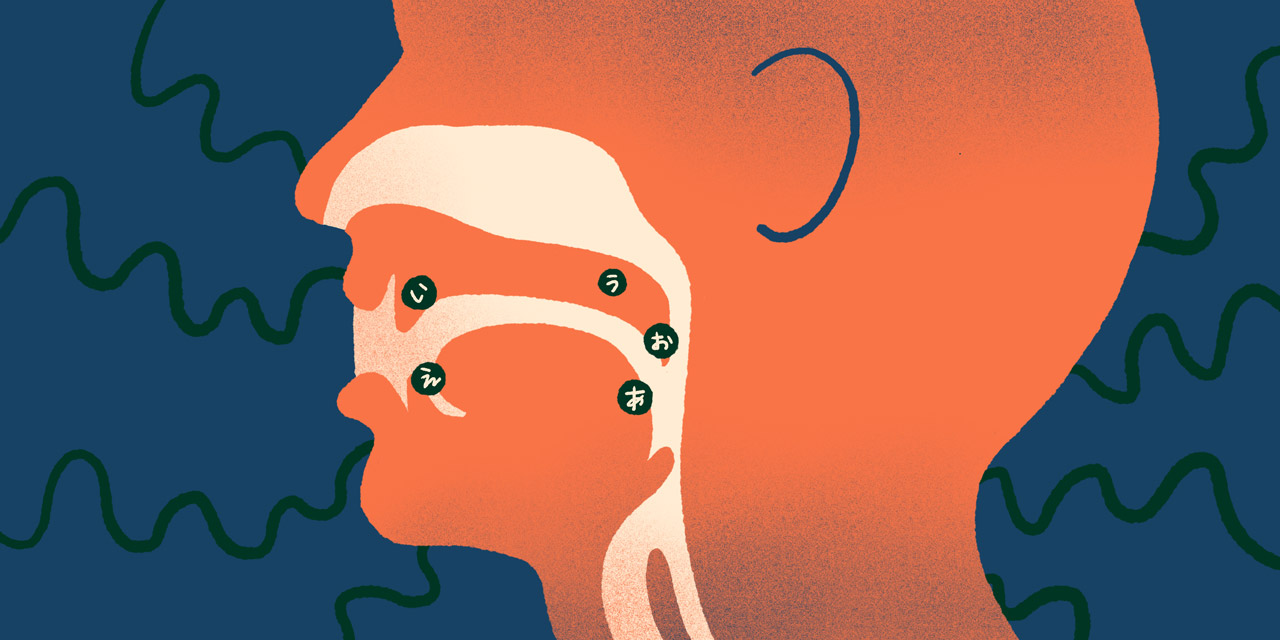
あ = low, center
い = high, front
う = high, back
え = mid, front
お = mid, back
Now say each of these sounds out loud, and feel where your tongue is in your own mouth as you imitate the audio. Feel it move forward and backward as well as up and down.
- あ
- い
- う
- え
- お
That's it! Those are all of the vowel sounds in Japanese, and the best thing is that they pretty much never change. They're always pronounced the same way, no matter what word they're in, and what they come before or after doesn't change them. This is rare in other languages, like English, where the vowel "a" could be pronounced differently depending on where it is in a word.
Say these words aloud:
cat
care
car
caw
Did you feel your tongue move around? They are all short words with "a" as the middle vowel, but each of them are made with your tongue in a different position in your mouth. This is one of the reasons that English can't be called a phonetic language. Those are actually four different sounds, and in IPA (the International Phonetic Alphabet) we use four different symbols to represent them because, for the sake of pronunciation, they're different vowels.
cat: æ
care: eə
car: ɑ
caw: ɔ
So while it may seem that we have the same number of vowels as Japanese in English, it's only true for the written language. In reality, English is a much more phonetically rich language—there are actually more sounds than it seems!
Consonants
Consonants are created when the air is blocked on its way out of your body.
Consonants have a few more things going on than vowels, and are created when the air is blocked on its way out of your body. Remember, vowels don't have any blockage, they're only affected by your tongue's position, but your tongue isn't actually blocking any of that air from getting out. It's shaping the air so that the sound changes slightly before it exits.
There are four important things to consider when we make consonants:
- Where the sound is blocked
- How the sound is blocked
- If your vocal cords vibrated
- If it went through your mouth or your nose
Where the Sound Is Blocked
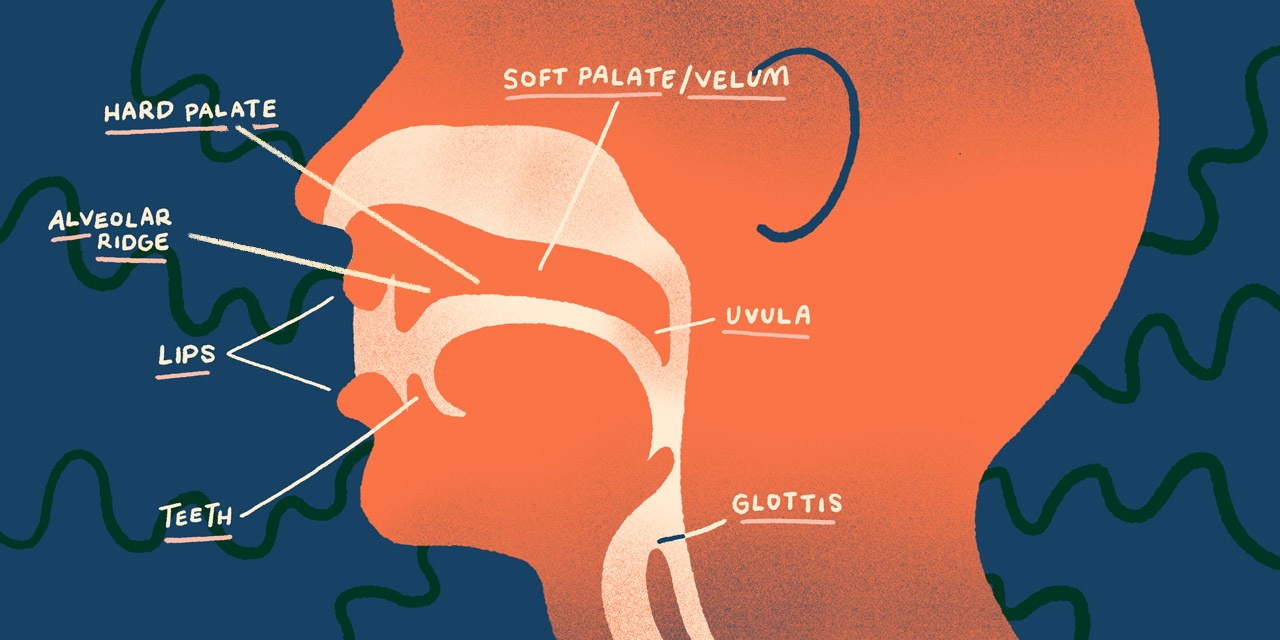
There are different places in your mouth where sound can be blocked and what parts can do the blocking. Thanks to biology and linguistics coming together, all of these body parts have names.
Lips: The mouth openings you use for smooching and smiling.
Teeth: The hard points you use to chomp food.
Hard Palate: The smooth and solid area located at the roof of your mouth.
Alveolar Ridge: The raised bony ridge, covered by gums, directly behind the upper teeth that contains the sockets of your teeth.
Soft Palate (Velum): The fleshy and soft part behind the hard palate that doesn't have any bones or ridges.
Uvula: The dangly tissue in the back of your throat.
Glottis: The opening between your vocal cords.
If you moved your tongue around your mouth or looked in the mirror while you read that, you're using this guide correctly. I highly recommend you explore your mouth to see and feel these bits (but don't touch your uvula, it'll make you throw up).
How the Sound Is Blocked
How the air is being blocked in your mouth goes hand-in-hand with where it's being blocked. We also have terms for the different types of blockage that go on in there.
Stops: The air is being completely blocked.
Fricatives: The air is being forced through a narrow opening and is not completely blocked, instead this narrow opening creates "friction," thus the name "fricative."
Affricates: This is a combination of a stop and a fricative. The air is stopped for a short time and then released through a narrow opening, creating friction.
Liquids: Similar to fricatives, but with less friction, allowing more space for the air to move through.
And then there's the special case:
Glides: A mix of a vowel and a consonant, sometimes called a "semivowel." They're almost exactly like vowels except that you move more than your tongue to make them. They act like consonants in Japanese, so we put them here.
Vocal Cords
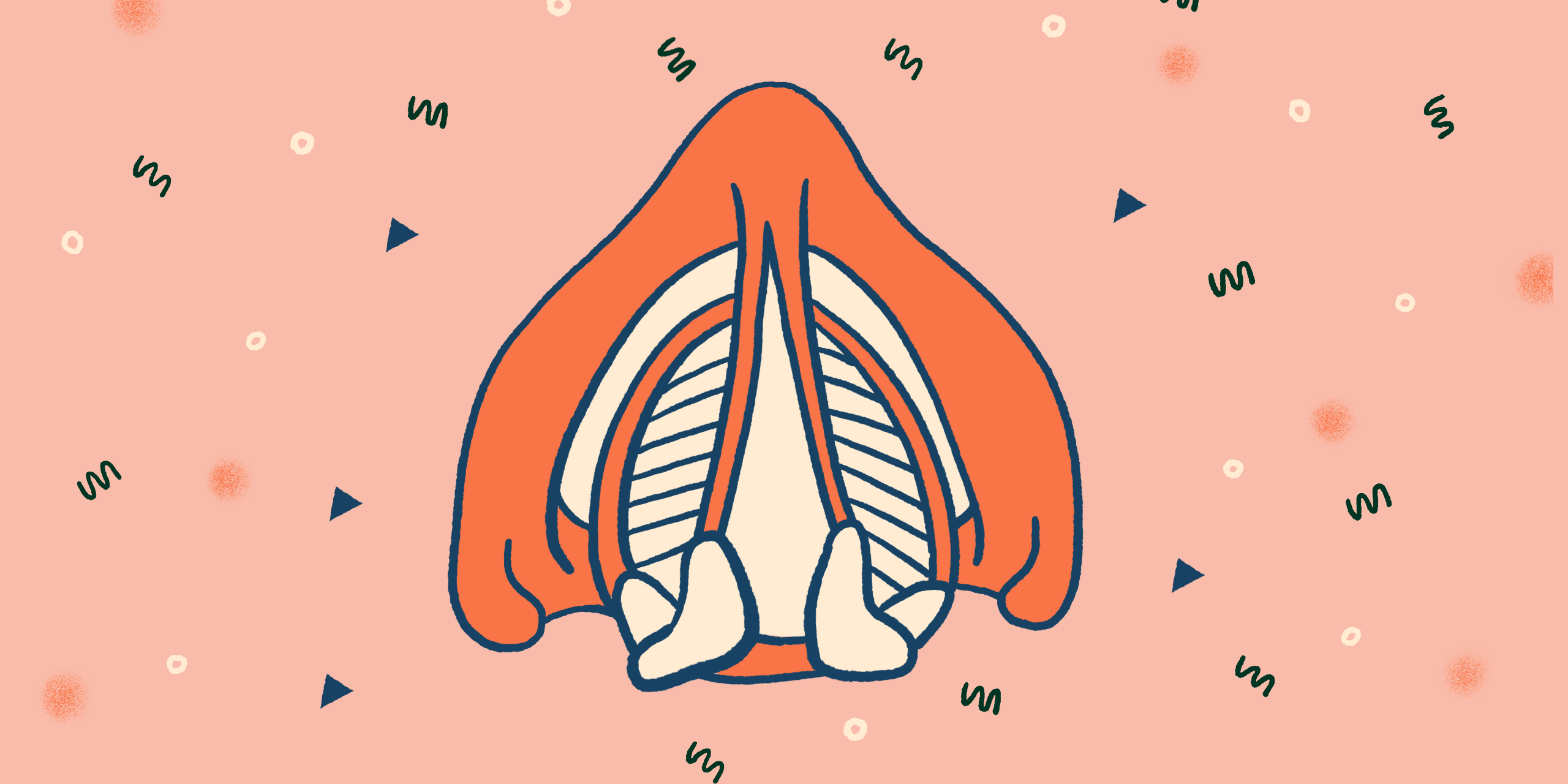
Your vocal cords (or vocal folds) are these two little flaps of membrane that live in your throat and control how much air goes out of your trachea, which is the tube that leads into your lungs (as opposed to your stomach). They open when you breathe, and constrict causing them to vibrate when you speak. Every time you make a vowel sound, your vocal cords are vibrating. That vibration is the origin of the sound you then shape with your tongue, lips, and other mouth parts.
But not all consonants need the vocal cords to vibrate to create a sound. Your body is capable of making sounds without needing your vocal cords. Try to make kissy-sounds with your lips. Or snap your fingers. You didn't need your vocal cords to make those sounds, but you still made them with your body, and you could hear them.
We call consonants that do vibrate the vocal cords voiced consonants. While consonants that do not vibrate the vocal cords are then unvoiced consonants.
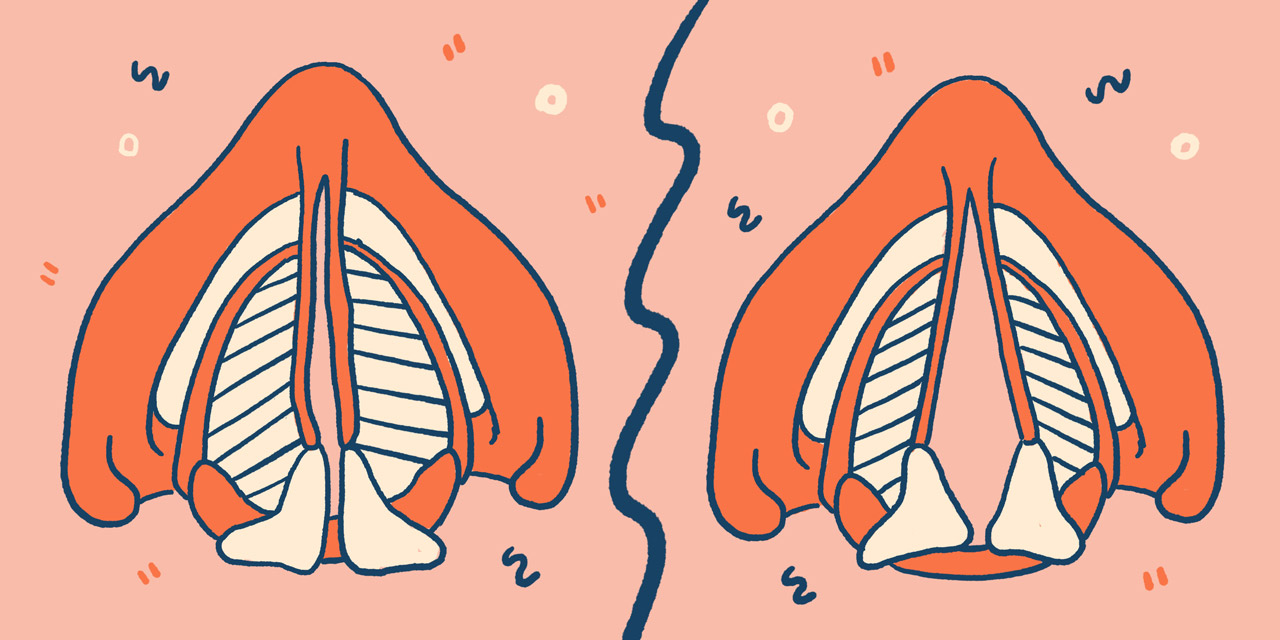
For this same reason, all vowels in Japanese are considered voiced because they all require your vocal cords to vibrate. The name "vowel" actually comes from the word for "vocal," so that should help you remember vowels are voiced.
Another bonus we get from hiragana being a phonetic syllabary is that all voiced consonants are marked with little markings called diacritics.
゛(dakuten) means a sound is voiced
゜(handakuten) means an h turns to a p
Mouth vs Nose

A sound's final destination is how it leaves (or tries to leave) your body. After its journey from your lungs, past your vocal cords, and up into your face it has two methods of escape: your mouth and your nose. This is where we can go back to our first important thing: where is the sound being blocked?
If the air is going into your mouth, then we call this an oral consonant. But if the air is going into your nose to make the sound, we call it a nasal consonant.
When talking about consonants, oral consonants are much more common in Japanese and English. This means they're usually omitted when explaining a sound, just like saying a "voiced vowel" is redundant, you usually don't see something called an "oral consonant," and instead nasal consonants will be marked as the outliers.
Let's go over the different consonant sounds in Japanese so you can feel exactly what's happening in your own mouth. These won't be in aiueo order, which you probably used to learn hiragana. Instead, we're going to travel through your mouth based on the order of the important things above. Think of it like a tour of your own mouth parts.
Remember to keep these four important questions in your mind:
- Where is the air being blocked?
- How is the air being blocked?
- Did your vocal cords vibrate?
- Did the air go through your nose or your mouth?
We have some special adjectives that answer each one.
- Bilabial = both lips
- Alveolar = alveolar ridge
- Velar = velum/soft palate
- Nasal = nose
- Palato-Alveolar = The space where the alveolar ridge and the hard palate meet
- Glottal = glottis
- Uvular = uvula
Voiced Bilabial Stops: ばびぶべぼ
Voiceless Bilabial Stops: ぱぴぷぺぽ
Voiced Bilabial Nasal Stop: まみむめも ん
Both of your lips are coming together to completely stop the air. There are three types of bilabial stops in Japanese: b, p, and m.
- ば
- び
- ぶ
- べ
- ぼ
- ぱ
- ぴ
- ぷ
- ぺ
- ぽ
- ま
- み
- む
- め
- も
- ん
Voiced Alveolar Stop: だでど
Voiceless Alveolar Stop: たてと
Voiced Alveolar Nasal Stop: なにぬねの ん
Your tongue is hitting right behind your teeth to completely stop the air. There are three types of alveolar stops in Japanese: d, t, and n.
- だ
- で
- ど
- た
- て
- と
- な
- に
- ぬ
- ね
- の
- ん
Voiceless Velar Stop: かきくけこ
Voiced Velar Nasal Stop: ん (sometimes がぎぐげご)
The middle of your tongue is hitting your velum/soft palate to completely stop the air. There are three types of velar stops in Japanese: g, k, and in some accents a nasal g sound that we don't have in English, and looks like this in IPA: ŋ. More on that later.
- が
- ぎ
- ぐ
- げ
- ご
- か
- き
- く
- け
- こ
- ん
Voiceless Bilabial Fricative: ふ
Your lips are forming a small opening, creating friction, for the air to pass through. There is only one of these in Japanese and none in English, but it's in between f and h. More on that later.
- ふ
Voiced Alveolar Fricative: ざずぜぞ
Voiceless Alveolar Fricative: さすせそ
Your tongue is creating friction close behind your teeth. There are two types of alveolar fricatives in Japanese: z and s.
- ざ
- ず
- ぜ
- ぞ
- さ
- す
- せ
- そ
Voiceless Palato-Alveolar Fricative: し
The tip of your tongue is creating friction close behind the alveolar ridge. This is the only one in Japanese, and it's slightly further back than its English counterpart: sh.
- し
Voiceless Palatal Fricative: ひ
The body of your tongue is creating friction close to your hard palate. There is only one in Japanese, and it has no match in English. More on that later.
- ひ
Voiceless Glottal Fricative: はへほ
You're creating friction between your vocal cords, at the glottis, which is the name for the opening between them. Basically these folds are coming closer together than they normally do, and the sound is coming from that friction. There is one glottal fricative in Japanese: h.
- は
- へ
- ほ
Voiced Alveolar Affricate: づ
Voiceless Alveolar Affricate: つ
Your tongue is stopping behind your teeth, then releasing, creating friction. There are two alveolar affricates in Japanese: dzu and tsu.
- づ
- つ
Voiced Palato-Alveolar Affricate: じぢ
Voiceless Palato-Alveolar Affricate: ち
The tip of your tongue is stopping behind the alveolar ridge, then releasing, creating friction. There are three palato-alveolar affricates in Japanese: ji, dzi, and chi. Although じ and ぢ used to be pronounced differently, they are now considered the same sound, with the exception of a few regional dialects.
- じ
- ぢ
- ち
Voiced Alveolar Liquid: らりるれろ
Alveolar liquids in Japanese are special because they do something called an alveolar tap. This means the tip of your tongue is touching the alveolar ridge for just a moment before releasing. There is one alveolar liquid in Japanese, which is usually represented with an r, but don't be fooled. They aren't the same sound. More on that later.
- ら
- り
- る
- れ
- ろ
Voiced Velar Glide: わ
The body of your tongue is moving toward your velum/soft palate, and your lips are moving closer together. There is one velar glide in Japanese: w.
- わ
Voiced Palatal Glide: やゆよ
The body of your tongue is moving toward your hard palate. There is one palatal glide in Japanese: y.
- や
- ゆ
- よ
Voiced Uvular Nasal: ん
The body of your tongue is touching your uvula, but it probably feels like it isn't that far back. There is one uvular nasal in Japanese: n.
- ん
Important Differences
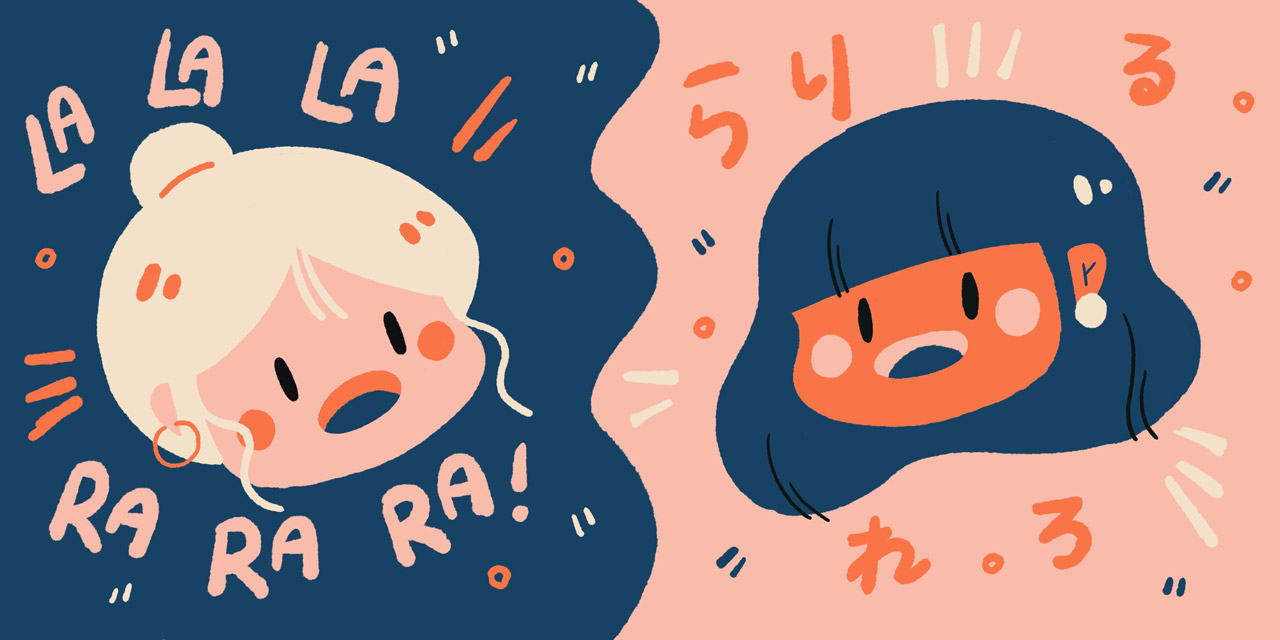
Now let's get into all of those "more on that later" stuff we put off earlier. Just because Japanese doesn't have as many sounds as English, doesn't mean the ones they do have are exactly the same. There are a few important differences that will help you sound more like a native speaker and less like a Japanese learner.
ふ
Hiragana teaches this as hu or fu, but these aren't accurate because this sound doesn't exist in English. The English fu is made by stopping the air with your bottom lip and your teeth. This is a labio-dental stop, which as you probably noticed, isn't even in our list of Japanese mouth sound adjectives. That's because they just don't have any.
The ふ sound is made by blowing air through a narrow space between both lips, making it a bilabial fricative.
- ふるい
- おふろ
- ふくろう
- おふだ
ひ
Hiragana teaches this as hi, but sometimes it sounds less like heat and more like the German ich or the English huge, when an old man says it kinda of exaggeratedly. For some people this is very easy to hear, while other people may make their h sound much closer to ours in English. The man in the following audio, has a very clear Japanese ひ.
- ひと
- ひとり
- ひろい
ん
Did you notice that ん showed up on our list four times?! That's because this is the most inconsistent sound in Japanese. In fact, just its existence is unique because it's the only consonant in Japanese that isn't a syllable in the traditional English sense.
ん is a consonant without a vowel after it. It changes in pronunciation depending where it is. It is the biggest exception in all of the Japanese sounds!
How to pronounce it depends on where it appears.
ん → n
- よん
- てんのう
- ほんです
ん → m
- せんぱい
- しんぶん
ん → ŋ
- せんご
- ほんが
When ん changes based on where it is, it is called "coarticulation," and it happens in English too. Your brain is basically deciding that it's easier for your mouth to say it this way. Listen once more to "shimbun."
- しんぶん
Pronouncing ん correctly is super important because of the confusion it can cause with なにぬねの. This is a common issue with English speakers in Japan, especially people reading romaji pronunciations from guides and travel books.
Let's say you're in the city of Itami and you want to find New Itami Station. This is spelled shinitamieki in romaji. But it's pronounced:
- しんいたみえき
However, if you mistake that for:
- しにたみえき
Did you notice that ん showed up on our list four times?! That's because this is the most inconsistent sound in Japanese.
It sounds like you're saying, "I feel like I want to die Station" not "New Itami Station."
There are over fifty cases where switching ん with なにぬねの just in train station names can make you end up in the wrong place. We checked! So it's pretty important that you're able to read hiragana and pronounce it, especially without relying on romaji.
らりるれろ
The Japanese r/l sound is the sound people get tripped up by the most. Probably because it seems like it should be pronounced like the two English sounds it gets translated to the most: r and l.
Let's take a look at those English sounds:
They're both alveolar voiced liquids (alveolar ridge plus less friction than other consonants), like the Japanese らりるれろ, but the tongue is doing very different things:
r: the tongue is in the middle of the mouth, curled up, and not touching any other parts.
l: the tip of your tongue is touching your alveolar ridge, but the air is moving around the sides.
らりるれろ: the tip of your tongue is touching the alveolar ridge quickly, then releasing.
While they are all voiced, in the same area, and let quite a bit of air through, your tongue is doing different things.
- ら
- り
- る
- れ
- ろ
If you have to compare it to English, think of the r/l location but the d sound.
を
While you may spell this "wo" when you're typing, を is pronounced like お when you're talking and using it as a particle. However, in songs and old Japanese, you'll sometimes hear it pronounced as "wo."
- を
じ/ぢ and ず/づ
In modern Japanese, these pairs of voiced sounds, じ/ぢ and ず/づ, are pronounced exactly the same way. There are a few regional dialects in which people still differentiate these sounds. However, because of the widespread influence of the Tokyo accent, the difference in pronunciation is becoming less significant.
Despite these shared sounds, in written Japanese, you won't encounter ぢ or づ as much as you do じ or ず. This is because づ and ぢ are only used when つ and ち are voiced in cases of rendaku or repeating sounds. Here are some examples.
- つづく
- はなづまり
- ちぢまる
- ちかぢか
Pronouncing Vocabulary
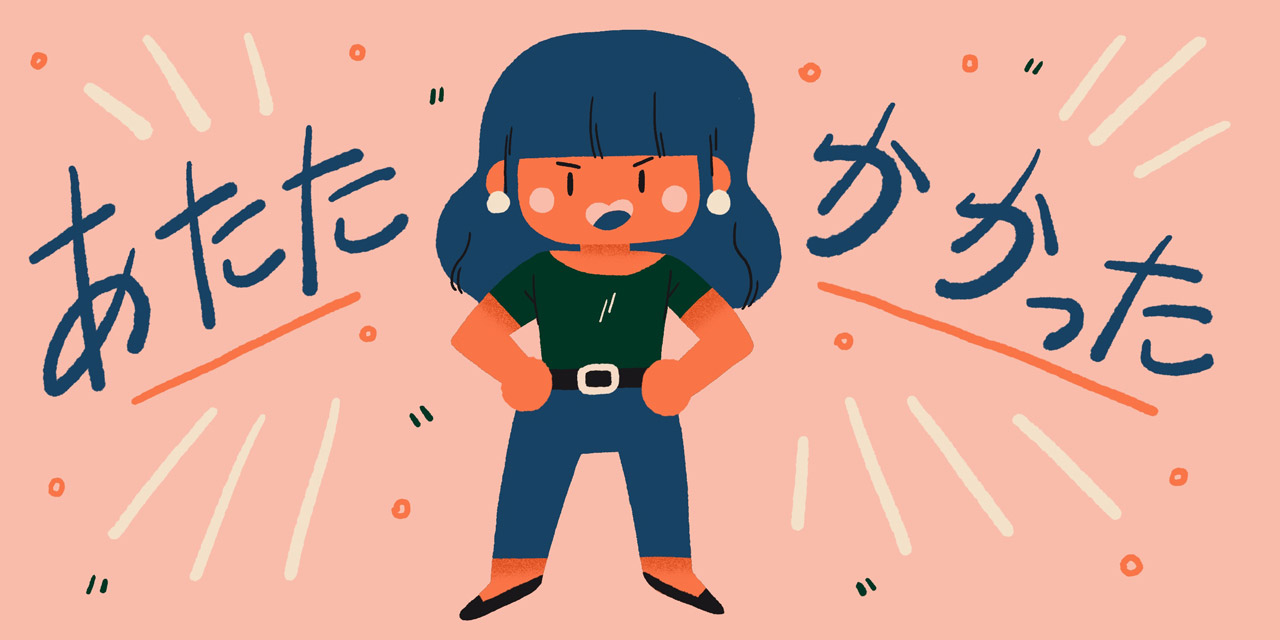
You know how to pronounce all the sounds! But making words is more than just shoving those separate sounds together to make words. Well, in some cases it isn't, but there are plenty of new things that come with pronouncing different Japanese words.
All of these are essential to pronouncing words clearly!
Short and Long Sounds
Japanese has different symbols for long and short sounds. In hiragana, long sounds are usually represented with a vowel and in katakana with the ー symbol. In hiragana, short sounds are represented with the っ commonly referred to as the "small tsu." Similarly, katakana uses its own small tsu ッ.
Long sounds:
- vowel sound followed by あいうえお
- ー
Short sounds:
- っ
- ッ
Let's practice hearing and saying the differences:
- りょうこう
- りょこう
- ローマ字
Can you hear the differences? A really helpful way to think about this difference is to focus on the emphasis. Japanese may not have stress or emphasis the same way as we do in English, but if you listen, you can hear that the long sounds have more stress. And the short sounds have stress on the other parts of the words they're in.
One very common mispronunciation of long sounds is between these two words:
- かわいい
- こわい
かわいい means cute. こわい means scary. Many new learners mix the two up and call people scary when they mean to say they're cute. Hear the difference? Now you won't make this mistake!
Double Consonants
While it doesn't look like there are two consonants here, we write them that way in English. This means the consonant takes up extra time and sounds like a pause is happening before it. This is called "gemination."
- きっぷ
- ちょっと
- がっこう
Don't mix these two up!
- ようか
- よっか
One is a long sound and the other is a double consonant. Can you hear how different they sound? One means eight days, and the other means four days—you definitely don't want to get those wrong.
You can also hear this when ん and なにぬねの meet, but because ん is our special exception symbol, this isn't represented with っ.
- てんのう
Dropping す ち and し
One of the first things new learners are corrected on is their pronunciation of です and ます. Looking at them, it seems straightforward: combine the two sounds, and you get the pronunciation, but it isn't so simple.
The す sound has a habit of dropping its vowel -u. This is called "devoicing."
- です des
- ます mas
- すき ski
It's especially common at the end of a word or before certain consonants.
And す isn't the only sound that gets devoiced. ち and し are other common offenders.
- しち
- わかりました
- すずきさん
Can you hear how short they sound?
Nasal が
This is a regional change, but it's not uncommon, especially if you spend time with people older than you. Certain areas of Japan change the g sounds of がぎぐげご to the nasal velar stop you know as ん. Let's listen to a man with this accent, pay close attention to how nasal the g sounds get.
- ながい
- つぎ
- あげる
It may sound like these words are being pronounced wrong, but they're not! It's just another variation that pops up from time to time.
Pitch and Speaking Japanese

If you've ever tried speaking Japanese to a Japanese person, and they didn't understand you even though you definitely said the right words, there is a high chance it's your pitch that threw them off.
The final ingredient to pronouncing Japanese words correctly is pitch.
Japanese is not like English—it does not have stress or emphasis that determines how to pronounce each word. Nor is it like Mandarin, as it does not have tones that denote meaning. But it's not a "flat" language either, which seems to be a common assumption and mistake even among teachers.
Pitch in the context of speaking Japanese is similar to what we talk about in singing a song. These are the notes that go up and down on a scale. While the exact notes aren't always the same and can differ depending on where in Japan you are, copying the pitch accents of those around you will help you sound like a native.
If you've ever tried speaking Japanese to a Japanese person, and they didn't understand you even though you definitely said the right words, there is a high chance it's your pitch that threw them off.
While we won't go into everything here, because Japanese pitch accent can get pretty technical, let's cover some of the basics.
Pitch Accent Patterns
We talk about pitch in Japanese in terms of highs and lows. The actual starting position differs based on your natural speaking voice and range. Think of it this way: the tune is the same, but the key changes based on the instrument (i.e. the voice of the person).
There are a few basic rules that can help you immensely in learning how to pronounce words like a native:
- If a word starts low, the next sound goes high
- If a word starts high, the next sound goes low
- Most long words go low again near the end
There are many ways to look up each individual word to make sure you're pronouncing it the correct way, which our friend Dogen went over a while back. If you really want to get into it, I'll leave you in his hands.
We made some handy examples of almost all of the pitch accent combinations you'll hear in Japanese. Listen to each one, and see if you can hear the patterns as they're indicated in the "Pitch Pattern" column with just two letters:
H: High
L: Low
Note: The letter in parentheses shows the pitch of the particle that follows the word, and isn't included in the audio. So for example, the LH(H) pitch pattern for 水 tells you that 水 itself has a low pitch followed by a high pitch, and that the は in 水は — or the を in 水を — would have a high pitch.
In no universe do you ever need to memorize these patterns. They're just here to give you a feel for how Japanese words naturally rise and fall. Messing them up a little bit probably won't hurt anything, and Japanese people will almost always know what you mean, even if you don't get the pitch quite right.
However, if you nail your pitch, you'll sound more like a native than the average second-language Japanese speakers out there.
Same Spelling, Different Pitch
There are a few cases where Japanese words seem to share the same pronunciation, but actually have different pitch accent patterns.
| Pitch Pattern | Japanese | Reading | English | |
|---|---|---|---|---|
| HL(L) | 箸 | はし | Chopsticks | |
| LH(L) | 橋 | はし | Bridge | |
| HL(L) | 神 | かみ | God | |
| LH(L) | 紙 | かみ | Paper | |
| LH(L) | 髪 | かみ | Hair | |
| LH(H) | 酒 | さけ | Alcohol | |
| HL(L) | 鮭 | さけ | Salmon | |
| LH(H) | 飴 | あめ | Candy | |
| HL(L) | 雨 | あめ | Rain |
These little differences are where knowing pitch accent can really help you sound like a real natural!
Why not try and see if you got it? We made a listening test with the above words in sentences. Download it below by joining our mailing list.
Warning: Remember that accents change depending on where you are and where the people you're talking to grew up. There is no "one accent" that all of Japan shares, just like how there are tons of different ways to pronounce words in English.
Pronouncing Phrases and Sentences

Pitch is also important when you combine these words into longer phrases and finally sentences. The trend in Japanese is that phrases start high and gradually go lower. Phrases are usually broken up by particles and punctuation, letting you take a breath and build back up again.
Let's look at some examples of how pitch builds and falls, first with some phrases, and then with full sentences.
- コウイチは毎朝
- Every morning Koichi

- カレーを食べながら
- while eating curry

- 日本語を勉強します
- studies Japanese

Can you see and hear how each phrase starts high and slowly lowers? Let's look at the entire sentence.
- コウイチは毎朝、カレーを食べながら日本語を勉強します。
- Every morning Koichi studies Japanese while eating curry.

Each phrase is separate even in one sentence. Here we have two pauses, once after the comma, once after ながら, a grammar point that means "while doing."
Each word still has its own pitch accent, but they blend together a bit in each phrase. Letting you pause at the right places does a few important things for your Japanese pronunciation:
- You have time to think about the next phrase. If you try to say one long string of words it's really easy to get tongue-tied. Take a breath here and reset.
- It makes what you're saying clear and easy to understand. If you blurt out a long sentence it may be hard for native speakers to understand what you're saying, because…
- Native speakers pause at these parts too! We have pauses like this in English too, so make sure you aren't talking like a speed demon for no reason.
Okay, let's look at another sentence.
- 昨日
- Yesterday,

- 生まれて初めて
- for the first time in my life

- 腹踊りをしました
- I did Japanese belly dancing

- 昨日生まれて初めて腹踊りをしました。
- Yesterday, I did Japanese belly dancing for the first time in my life.

Once again we have two pauses, once after 「昨日」and once between the two phrases 「生まれて初めて」 and 「腹踊りをしました」. Let's look at and listen to a few more sentences.
- 歯磨きをした後
- After you brush your teeth

- パジャマに着替えて
- change to your jammies

- ベッドに行きましょう
- and go to the bed

- 歯磨きをした後パジャマに着替えてベッドに行きましょう。
- After you brush your teeth, change to your jammies, and go to the bed.

We see the same pattern here as we did in the sentence before it. After you「歯磨きをした後」 you 「パジャマに着替えて」 and then 「ベッドに行きましょう」.
- テレビを見る時は
- When you watch TV

- 部屋を明るくして
- you should keep the lights in the room on

- 少し離れて見る方がいいですよ
- and watch it from from a bit of a distance

- テレビを見る時は、部屋を明るくして、少し離れて見る方がいいですよ。
- When you watch TV, you should keep the lights in the room on and watch it from from a bit of a distance.

- 発音の勉強が
- learning pronunciation

- こんなに面白いものとは
- would be this interesting

- 思ってもみなかったです
- I never thought that

- 発音の勉強が、こんなに面白いものとは、思ってもみなかったです。
- I never thought that learning pronunciation would be this interesting.

If you want to ace a Japanese speaking contest, using these types of pitch patterns and pauses can be the difference between a win and an "honorable mention."
While not all sentences are nicely broken up like this, these rise and fall patterns and pauses are extremely common in spoken Japanese. And if you want to ace a Japanese speaking contest, using these types of pitch patterns and pauses can be the difference between a win and an "honorable mention."
Each of the breakdowns above were made using a wonderful website called Prosody Tutor Suzuki-kun, made by the people behind the Online Japanese Accent Dictionary. Their pronunciation studies and tools can be invaluable when it comes to learning how to pronounce words, phrases, and sentences in Japanese.
If you'd like to use their tools, specifically for parsing out longer sentences like those above, they have a small English guide here. Eventually, you'll outgrow it, picking up the cadence and pitch of the Japanese speakers you interact with. But until then, use tools like this to impress your Japanese teachers, tutors, and friends with how natural your pronunciation sounds.
For the fun of it, we also recorded some "natural" versions of these sentences as well, so you can hear the difference between the radio and speech friendly accent above and the everyday conversational accent below. If you can say these sentences with the same speed, accent, and tempo, you'll be speaking like a Japanese pro in no time.
- コウイチは毎朝、カレーを食べながら日本語を勉強します。
- Every morning Koichi studies Japanese while eating curry.
- 昨日生まれて初めて腹踊りをしました。
- Yesterday, I did Japanese belly dancing for the first time in my life.
- 歯磨きをした後パジャマに着替えてベッドに行きましょう。
- After you brush your teeth, change to your jammies, and go to the bed.
- テレビを見る時は、部屋を明るくして、少し離れて見る方がいいですよ。
- When you watch TV, you should keep the lights in the room on and watch it from from a bit of a distance.
- 発音の勉強が、こんなに面白いものとは、思ってもみなかったです。
- I never thought that learning pronunciation would be this interesting.
We also recorded a podcast about Japanese pronunciation where we ask more questions, mess up (for your education, of course), and make a ton of mouth noises into the mic. You can subscribe to The Tofugu Podcast for more on the Japanese language and Japan on Apple Podcasts, Soundcloud, or wherever you get your podcasts.
-
This changes when we talk about kanji, but pronunciation and kana go hand-in-hand so we're focusing on the basics for now. ↩
